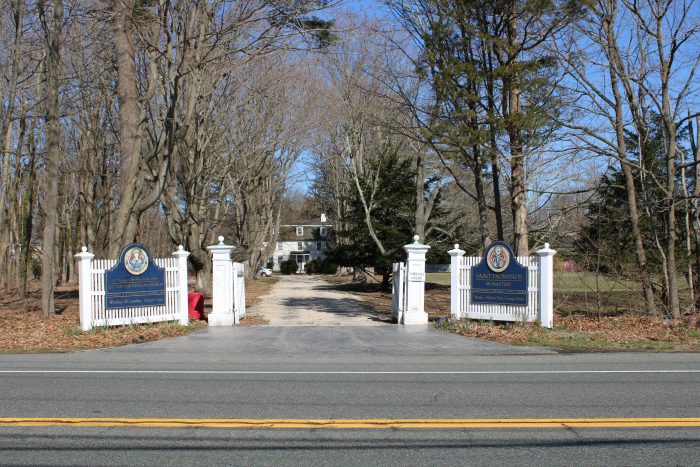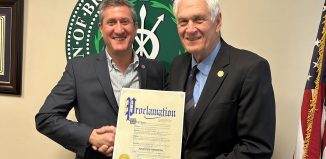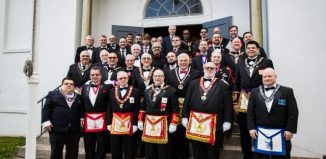Head of the Harbor holds public hearing on church application

A packed room full of Head of the Harbor residents gathered last Wednesday, May 17, for a public hearing on the application of the Monastery of Saint Dionysios the Areopagite, also known as the Monastery of the Glorious Ascension, that occupies the historic Timothy House, to build a church on the property.
The monastery, which purchased the house in 2018, is seeking a special-use permit for religious purposes, to build the church, which will be about 3,341 square feet. As previously noted by the The Times of Smithtown (March 30, 2023), Timothy House, constructed in the 1800s, was once the home of former Head of the Harbor historian and architectural preservationist Barbara Van Liew, who died in 2005. The house was built by a descendant of Smithtown founder Richard Smith. In honor of Van Liew, community members passed out buttons with her photo reading, “Save Her Legacy.”
The village board listened to a presentation made by Joseph Buzzell, the attorney for the monastery along with public comments made by the community. A decision has not been made and the next meeting is on June 21. Public comment will be open until then.
Calls for recusal
At the start of the meeting Deputy Mayor Daniel White addressed calls from some community members to recuse himself from the application, as he has a family member in the monastery. He declined to step aside.
“A grandchild of one of my aunts is affiliated with the monastery,” White said. “While I know this individual, who he is, I have not had any significant conversation or other dealings with him in the last 20 years. I am not required to recuse myself here as a matter of law. I believe I can be fair and impartial in the assessment and determination of this application.”
Village Mayor Douglas Dahlgard stood behind White, and said the village is small, and most people know each other.
Plan details
Buzzell said the Monastery has received a letter from the State Historic Preservation Office noting that the house will have “no adverse impact on the Timothy Smith house.” SHPO is requiring the monastery to take photos of the site for documentation purposes. He added that the monks “have, do and will fully maintain the Timothy Smith house.”
The plan does not include any changes or modifications to the actual house.
“This is not an insensitive builder, demolishing a historic structure,” Buzzell said. “Part of the monastery’s proposal from the very beginning is to preserve and maintain the Timothy Smith house. It’s done so in the past, it does so now, it will continue to do so.”
Buzzell said that since the monks purchased the home, they have put over $340,000 into the maintenance of the property including structural repairs to the basement and east wing, emergency repairs to beams and front stoop, along with repairs to the roof, plumbing and sanitary systems, electrical repairs, repairs to leaks in the basement and roof and mold remediation.
The monastery is not presently proposing to widen the driveway, or add new lighting, Buzzell said. The attorney for the monastery said the decision about the driveway came up “late during the SHPO process.”
The foliage along 25A will also stay the same. A school is no longer part of the plan, according to Buzzell. It is proposed the church be situated 271.5 feet from the road and that 36 parking spaces be added to the property.
The project would tie the monks to the house, Buzzell said.
“This ties into the church functionally, to the property functionally, to tie them to the property financially, all of which serves to preserve the Timothy Smith house.”
Dahlgard questioned Buzzell as to if the monastery is able to afford the construction.
“My wife and I have two old houses in the village, and we know all too well the cost and the effort that goes into maintaining these houses including money,” he said.
Dahlgard continued: “Building a new 3,200 square foot church at today’s prices, the way things are, you’re talking somewhere close to a million dollars.” The mayor asked Buzzell if the village could get “assurances that [the monastery] has the ability to fund and finance construction.”
While Buzzell previously agreed to Dahlgard’s request to have a building inspector, he said he was “not involved in the financial aspects of the project but was sure” something could be worked out.
“If [the monks] didn’t feel that they could actually build and run that church, I would not be standing at this podium,” Buzzell said.
Parking concerns
Ethan Schukoske, a traffic engineer for the monastery said they host a large morning service on Sundays for approximately 35 to 40 members.
“They don’t expect a large increase of members,” he said. “Obviously they want to have some space … but it’s really a relocation of services in the Timothy House to their nicer facility on site.”
Schukoske said the facility had at most 40 cars entering the property during their Sunday peak period, according to his study, in which he observed traffic flow. He noted a maximum of 21 parked cars on site. When projecting the traffic using industry standard data from the Department of Transportation, a standard church of the same size would generate about an additional 17 cars and 31 parked cars, if projecting a typical church of the same size.
When trustee Jeffrey Fischer pointed out that the study was done in 2021, and it was still at pandemic levels, Schukoske said that around 20,000 vehicles travel on 25A each day, so “when you have less than 100 vehicles during the peak hour, it doesn’t have a significant impact.”
Community response
Erica Rinear, who lives next door to the monastery, said at the meeting the monks have always been good neighbors.
“They have been nothing but the most wonderful human beings,” she said. Rinear added that she and her husband used to call the section of 25A near their home “highway to heaven,” as there are a number of churches. She welcomes another.
“My husband just died February 5 of this year,” she said. “I like to think that this church will help me get to him directly.”
Leighton Coleman III, the village historian, had a number of concerns about maintaining the historic integrity of the space. He said the SHPO representative, who penned the approval letter for the home, told him she did not make a site visit to the house. He also was concerned that should the parking lot fill up, cars will be parked on 25A, blocking the view of the house.
Natasha Acker, a neighbor, said when she recently went to work, there were three construction vehicles in front of her. Parishioners have also walked up to her fence line, she said. Finally, she was concerned her home would decrease in value after the construction of the church.
“Say somebody here wants to retire tomorrow,” she said. “It may be years of construction before they’re able to sell their home because nobody wants to buy a home, especially a nice million-dollar historic home, next to a construction area.”






